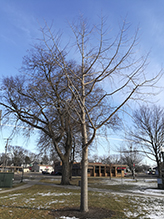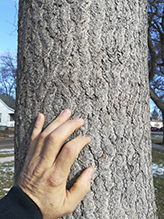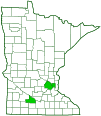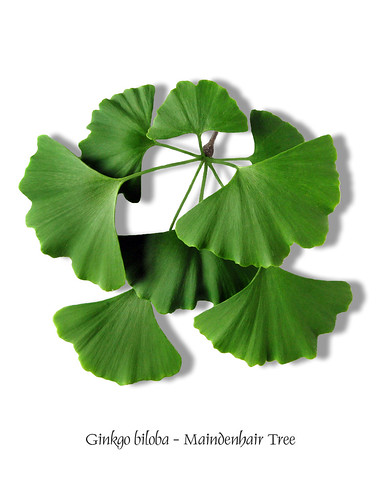ginkgo
(Ginkgo biloba)
Conservation • Description • Habitat • Ecology • Use • Distribution • Taxonomy
Conservation Status |
|
|||||||
| IUCN Red List | EN - Endangered |
|||||||
| NatureServe | NNA - Not applicable |
|||||||
| Minnesota | not listed |
|||||||
Description |
||
Ginkgo is a medium-sized, slow-growing, extremely long-lived, deciduous tree rising on a single trunk from a deep root system. In Minnesota mature trees are usually 40′ to 60′ tall and up to 30″ in diameter at breast height. In other areas it often reaches 100′ or more in height and 40″ in diameter. It frequently reaches ages of at least 300 years. Reports of temple trees in China over 1,000 years old are presumably based on wishful thinking. The genus Ginkgo dates from the Early Jurassic epoch, about 200 million years ago. It is the oldest surviving genus of any seed plant. Fossil records show that there were several species in the genus and that it was abundant over a wide area. Ginkgo biloba is the only extant species. It remains relatively unchanged in form from its earliest fossils. The two last known wild populations are on West Tianmu Mountain, in the Tianmu Mountain National Nature Reserve, in the Zhejiang province of eastern China. The genetic uniformity of these two populations suggest that they were cultivated by monks, and that the species is now extirpated in the wild. The trunk is straight, tapered, and distinct into the top of the crown. The crown is slender egg-shaped to inversely egg-shaped when young, becoming asymmetric and much broader with age. The branches are mostly ascending at about a 45°, the lower ones sometimes horizontal. The bark on young trees is light grayish-brown and shallowly fissured. On mature trees the bark is brown, corky, and deeply furrowed. The twigs are stout, smooth, finely and faintly grooved, and yellowish-green at first, becoming grayish-brown. Older twigs have prominent, thick, knob-like or up to 1 3 ⁄16″ long spur shoots at regular intervals. The spur shoots are covered with rings of bud scale scars, each ring indicating one year of growth. The leaf scars have 2 bundle scars. The buds are brown and have 2 overlapping scales. Two types of leaves are produced: early (preformed) leaves; and late (neoformed) leaves. Preformed leaves overwinter in the bud and are fully formed or almost fully formed before the buds burst in the spring. They are the first leaves to mature in the spring. Neoformed leaves are all of the subsequent leaves produced on long shoots. They are formed in the same season that they emerge. The leaves appear alternately on long shoots and in clusters at the end of spur shoots. They are on slender, 1″ to 3½″ long leaf stalks. The leaf blades are deciduous, light green, fan-shaped, 1″ to 2″ long, and 1½″ to 3″ wide, about 1.5 times as wide as long. The edge is shallowly, irregularly toothed or just wavy, and often has one or more notches. Preformed leaves often have just a single deep notch, giving rise to the species epithet biloba, meaning “two-lobed”. Neoformed leaves often have more than one notch. The blades have fine, straight, forked but parallel-appearing veins but no midvein. The leaves turn yellow in autumn. The other common name, maidenhair tree, refers to the similarity of the leaf shape to the maidenhair fern. Pollen (male) and seed (female) cones are borne on separate trees. Pollen cones appear on short shoots in drooping, 1 3 ⁄16 to 2⅜″ long, catkin-like clusters. Seed cones also appear on short shoots. They consist of two ovules at the end of a long stalk (peduncle). Typically, only one of the ovules matures in the autumn—the other usually aborts. The peduncle and ovules are covered with a whitish, waxy coating (glaucous). The maturing ovule becomes a yellow to orange, ⅞″ to 1 1 ⁄16″ long, ¾″ to ⅞″ wide, glaucous, wrinkled, fruit-like structure with a naked seed and thick fleshy covering. The seeds are shed from August to November. When they fall to the ground, the fleshy seed covering develops a disagreeable odor which persists on the skin if handled. |
||
Height |
||
40″ to 100″ |
||
Record |
||
No records are kept for non-native trees. |
||
Similar Species |
||
| No similar species | ||
Habitat |
||
Disturbed stream-side environments. Street sides, yards. |
||
Ecology |
||
Polination |
||
| March to April | ||
Pests and Diseases |
||
|
||
Use |
||
|
||
Distribution |
||||
|
Sources |
|||
| 4/22/2023 | ||||
Nativity |
||||
Native to China. Widely cultivated as an ornamental. Not naturalized anywhere. |
||||
Occurrence |
||||
Rare |
||||
Taxonomy |
|||
| Kingdom | Plantae (Plants) | ||
| Division | Tracheophyta (Vascular Plants) | ||
| Subdivision | Spermatophytina (Seed Plants) | ||
| Class | Ginkgoopsida (ginkgos) | ||
| Subclass | Ginkgooidae | ||
Order |
Ginkgoales (ginkgos) | ||
Family |
Ginkgoaceae (ginkgo) | ||
Genus |
Ginkgo (ginkgo) | ||
Classification of ginkgos at the higher taxonomic orders remains unsettled. Some place it in its own division (phylum) Ginkgophyta. Others place it in the division Gymnospermae in its own class Ginkgoopsida. Still others place it in the division Gymnospermae, the class Cycadopsida, and its own order Ginkgoales. |
|||
Synonyms |
|||
|
|||
Common Names |
|||
common ginkgo ginkgo ginkgo tree maidenhair tree |
|||
Though spelled oddly, the genus name is pronounced ˈgɪŋkoʊ. For that reason, the common name is often misspelled gingko. |
|||
Glossary
Bundle scar
Tiny raised area within a leaf scar, formed from the broken end of a vascular bundle.
Glaucous
Pale green or bluish gray due to a whitish, powdery or waxy film, as on a plum or a grape.
Peduncle
In angiosperms, the stalk of a single flower or a flower cluster; in club mosses, the stalk of a strobilus or a group of strobili.
Visitor Photos |
|||||
Share your photo of this plant. |
|||||
| This button not working for you? Simply email us at info@MinnesotaSeasons.com. Attach one or more photos and, if you like, a caption. |
|||||
Randy |
|||||
Ginkgo form and bark, December 2017, Freeborn County, MN |
|||||
 |
 |
||||
MinnesotaSeasons.com Photos |
|||||
|
|||||


Visitor Videos |
|||
Share your video of this plant. |
|||
| This button not working for you? Simply email us at info@MinnesotaSeasons.com. Attach a video, a YouTube link, or a cloud storage link. |
|||
Other Videos |
|||
| Ginkgo biloba - Maidenhair Tree Jeff Wortham |
|||
About
Published on Aug 11, 2012 Ginkgo biloba - Maidenhair Tree is a large deciduous tree with striking yellow Fall color. To learn more please watch the video. For information on many other plants please visit designwithplant.com |
|||
| Trees with Don Leopold - ginkgo ESFNature |
|||
About
Published on Jan 6, 2014 Don Leopold demonstrates the characteristics of ginkgo. Content produced by Christopher Baycura for the SUNY College of Environmental Science and Forestry (SUNY-ESF). |
|||
| Ginkgo biloba VT Dendrology |
|||
About
Published on Apr 18, 2016 ginkgo |
|||
| The Ginkgo's Secrets Harvard Magazine |
|||
About
Published on Oct 24, 2011 Gingko expert Peter Del Tredici shares highlights about his favorite "living fossil" at the Arnold Arboretum: http://goo.gl/kBzmL |
|||
| Ginkgo Tree - Ginkgo Biloba - Maidenhair Tree - Gingko GardenClips |
|||
About
Published on Nov 12, 2015 The Ginkgo Tree is one of the stars of mid-November. Many trees and shrubs have already dropped their leaves, closing off the connections from leaf to stem in preparation for the long winter ahead. But Ginkgo biloba and a few others hang in there, sometimes right into December. This is a problem for the homeowner who has to shovel early December snow on top of a load of wet leaves on the sidewalk. The ginkgo is classified in its own division, the Ginkgophyta, comprising the single class Ginkgoopsida, order Ginkgoales, family Ginkgoaceae, genus Ginkgo and is the only extant species within this group. Ginkgos are dioecious, meaning there are males of the species and females of the species, distinct individuals who must each contribute to the sexual reproduction of their kind. Of course, it is much preferred to be living near a male, although the fruits are considered important food crops in East Asia. More on that later. Besides G. biloba, no other member of the order Ginkgoales exists outside of the fossil record since the Pleistocene. The relatives harken back to the Permian, dating back 270 million years. The relatives and even this species evolved during the Jurassic in an era before flowering plants, when ferns and cycads (Ginkgo’s closest living relative) predominated, forming a low somewhat sparse canopy. This is one reason why Ginkgo biloba is often referred to as a fossil plant. Thought for the longest time to be extinct in the wild, several small areas of seemingly native stands were discovered in very distant parts of China. After genetic study, these were found to be so similar as to suggest that they were planted from one batch of seedlings. It is thought that these two patches were planted and preserved by Chinese monks over a period of more than a thousand years. Now that’s some environmental activism. Ginkgos are large trees, when given the right conditions. Growing in China up to 50 meters (around 150 feet), under cultivation they generally grow to around ninety to a hundred-and-ten feet, with a pretty narrow spread. They prefer full sun, a well drained but rich soil and adequate moisture. But they are supreme survivors, and will do well in some very forbidding soils, climates and conditions. They are extremely pollution tolerant, disease and pest resistant and tolerant of restricted root zones, which makes them a good candidate for a street tree. Not only that, as I mentioned earlier, they are a survivor of more than time: About 4000 feet from the hypocenter of the atomic bomb blast that leveled Hiroshima in 1945, a large Ginkgo tree lived outside of a temple. The shock wave and firestorm completely leveled that area, and defoliated the tree, but it budded out the following spring and still lives today, without any major deformities. For this reason it is called ‘the bearer of hope.’ By the way, the temple was re-built, and instead of taking down the tree as was suggested by some, they built around it, with steps on either side. Ginkgo, the national tree of China, has cultural and religious significance in Buddhism and Confucianism. Some cultivated specimens in Japan and China are over 1500 years old. The nutlet is used in congee and other traditional Chinese dishes, such as the vegetarian dish Buddha’s Delight, served for special occasions such as weddings and the New Year. Getting to the nutlet can be a smelly chore, though. Anyone who has experienced the fruit of the tree knows that the olfactory presence is not the most appetizing aroma. When my brother Jeffry attended Haverford College in the early 1960’s, there were two large female Ginkgos planted just outside what was then used as the dining hall. That’s one way to save on comestible costs for a horde of hungry young men. The herbal/medicinal uses of Ginkgo are all debatable. Studies have shown them to be effective in sharpening the memory, and other studies have shown there is no advantage. Besides memory enhancement, Ginkgo has also shown to be effective in delaying the on-set of dementia, easing some of the symptoms of tinnitus, relieving fatigue and contributing to the improvement in cognition. As I always write, this is not an endorsement of herbal uses for this plant, but I only attempt to report what it can or has been used for. Please consult an herbalist, your holistic health practitioner or other quack for helping diagnosing and prescribing cures for what ails ye. (Actually I firmly believe in holistic medicine, so please forgive my loose banter about the nature of that practice) The word comes from the Chinese word for the tree. It was brought back to Europe in the late 17th Century by the German botanist Engelbert Kaempfer. |
|||


Created: 1/6/2018
Last Updated:



